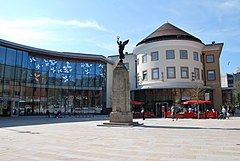Hook Heath, Woking
| Woking | |
|---|---|
 Jubilee Square, Woking Town Centre |
|
| Woking shown within Surrey | |
| Area | 63.57 km2 (24.54 sq mi) |
| Population | 62,796 (Town) 99,500 (Borough) |
| • Density | 988/km2 (2,560/sq mi) |
| OS grid reference | TQ003584 |
| • London | 23 mi (37 km) NE |
| District | |
| Shire county | |
| Region | |
| Country | England |
| Sovereign state | United Kingdom |
| Post town | WOKING |
| Postcode district | GU21, GU22 |
| Dialling code | 01483 |
| Police | Surrey |
| Fire | Surrey |
| Ambulance | South East Coast |
| EU Parliament | South East England |
| UK Parliament | |
| 2001 United Kingdom Census | |
|---|---|
| Country of birth | Population |
|
|
77,577 |
|
|
1,748 |
|
|
925 |
|
|
737 |
|
|
709 |
|
|
686 |
|
|
601 |
|
|
590 |
|
|
576 |
|
|
326 |
Woking (/ˈwoʊkɪŋ/) is a town in northwest Surrey, England. It is at the southwestern edge of the Greater London Urban Area and is a part of the London commuter belt, with frequent trains and a journey time of approximately 24 minutes to Waterloo station. Woking is 23 miles (37 km) southwest of Charing Cross in central London. Woking town itself, excluding the surrounding district, has a population of 62,796, with the whole local government district (the borough of Woking) having a population of 99,500 (mid-2011 estimate). Woking has been a Conservative area since the constituency was created in 1950, with Jonathan Lord re-elected as its Member of Parliament in the 2017 General Election.
Though Woking's earliest written appearance is in the Domesday Book, it is mentioned as the site of a monastery in an 8th-century context, as Wochingas. In the Domesday Book it appears as Wochinges, being held in 1086 by King William the Conqueror, Walter FitzOther, Constable of Windsor Castle, and Ansgot and Godfrey from Osbern FitzOsbern, then bishop of Exeter.
Modern Woking was formed in the area to the south of the Basingstoke Canal (opened in 1794) around the railway station, built in 1838 at the junction between lines to London, the south coast, and the south-west of England, and the private railway to Brookwood Cemetery, which was developed by the London Necropolis Company as an overflow burial ground for London's dead. As a result, the original settlement 1 mile to the south-east, on the River Wey, became known as "Old Woking". Later, Woking Crematorium at St John's became the first crematorium in the United Kingdom.
...
Wikipedia

